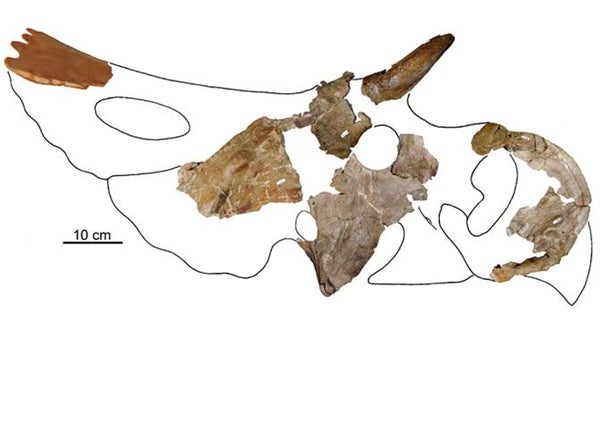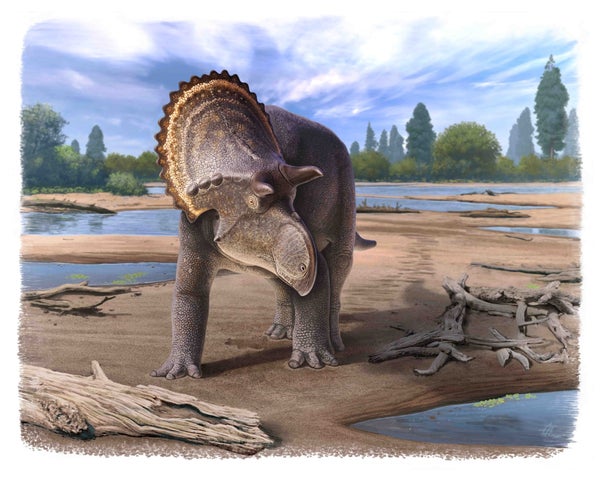This article was published in Scientific American’s former blog network and reflects the views of the author, not necessarily those of Scientific American
If you love horned dinosaurs, there's never been a better time to be alive. The number of new species discovered and described in the past 10 years has exploded like a frill full of bony spikes. This year alone has seen several new additions, with paleontologist Michael Ryan and colleagues adding another little teaser before 2016 is out.
Back in 1937 the famous fossil hunter Charles Sternberg dug up a partial skull from the Cretaceous rock of southern Alberta. He noted it as "specimen No. 12", which hazarded was a specimen of a small-sized horned dinosaur paleontologists of the time called "Brachyceratops." That skull eventually found its way to the Canadian Museum of Nature in Ottawa, but it's only in the context of more recent finds that the skull makes sense.
The skull, cataloged as CM 8804, doesn't have a scientific name yet. Some of the most salient parts of the skull from telling one horned dinosaur species from another - namely, the bones of the frill - are missing. But enough was dug up by Sternberg for Ryan and colleagues to tell that CM 8804 was a relative of Nasutoceratops from southern Utah. Both belonged to a subgroup of horned dinosaurs that the researchers have dubbed the Nasutoceratopsini.
This is more about reshuffling names. Between 80 and 75 million years ago, Ryan and coauthors point out, horned dinosaurs were splitting from each other like crazy, with each lineage taking on their own suite of distinctive ornamentation. There were two major lines - the chasmosaurs and centrosaurs - and the centrosaur group was further split into three parts. There were dinosaurs like Coronosaurus (long nose horn, short brow horns, spiky frills), Pachyrhinosaurus (large knobby boss instead of a nose horn, hooks on the frill), and Nasutoceratops (tiny nose horn, long brow horns, modestly-ornamented frills) overlapping with each other in time, if not space. But what caused these dinosaurs to vary so wildly from each other, and how did they coexist? That drama played out over millions of years, and it's one we're only just now starting to see.

The partial skull of CMN 8804. Credit: Ryan et al. 2016
Fossil Facts
On supporting science journalism
If you're enjoying this article, consider supporting our award-winning journalism by subscribing. By purchasing a subscription you are helping to ensure the future of impactful stories about the discoveries and ideas shaping our world today.
Name: There is no official scientific name yet. For now, the fossil is known as CMN 8804.
Age: Cretaceous, 79-76 million years ago.
Where in the world?: Southern Alberta, Canada.
What sort of critter?: A horned dinosaur belonging to a newly-named subgroup called the Nasutoceratopsini.
Size: The skull is estimated to have been a foot and a half long when complete.
How much of the creature’s body is known?: A partial skull.
Reference:
Ryan, M., Holmes, R., Mallon, J., Loewen, M, Evans, D. 2016. A basal ceratopsid (Centrosaurinae: Nasutoceratopsini) from the Oldman Formation (Campanian) of Alberta, Canada. Canadian Journal of Earth Sciences. doi: 10.1139/cjes-2016-0110
Previous Paleo Profiles:
The Light-Footed Lizard The Maoming Cat Knight’s Egyptian Bat The La Luna Snake The Rio do Rasto Tooth Bob Weir's Otter Egypt's Canine Beast The Vastan Mine Tapir Pangu's Wing The Dawn Megamouth The Genga Lizard The Micro Lion The Mystery Titanosaur The Echo Hunter The Lo Hueco Titan The Three-Branched Cicada The Monster of Minden The Pig-Footed Bandicoot Hayden's Rattlesnake Demon The Evasive Ostrich Seer The Paradoxical Mega Shark The Tiny Beardogs The Armored Fish King North America's Pangolin The Invisible-Tusked Elephant The Mud Dragon The Spike-Toothed Salmon The Dream Coast Crocodile Buriol's Robber Ozimek's Flyer
